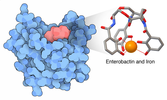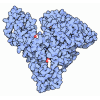[English] 日本語
 Yorodumi
Yorodumi- PDB-1nnt: STRUCTURAL EVIDENCE FOR A PH-SENSITIVE DI-LYSINE TRIGGER IN THE H... -
+ Open data
Open data
- Basic information
Basic information
| Entry | Database: PDB / ID: 1nnt | ||||||
|---|---|---|---|---|---|---|---|
| Title | STRUCTURAL EVIDENCE FOR A PH-SENSITIVE DI-LYSINE TRIGGER IN THE HEN OVOTRANSFERRIN N-LOBE: IMPLICATIONS FOR TRANSFERRIN IRON RELEASE | ||||||
 Components Components | OVOTRANSFERRIN | ||||||
 Keywords Keywords | IRON TRANSPORT PROTEIN | ||||||
| Function / homology |  Function and homology information Function and homology informationorganomineral extracellular matrix / iron ion transmembrane transport / antimicrobial humoral response / ferric iron binding / acute-phase response / recycling endosome / antibacterial humoral response / iron ion transport / response to lipopolysaccharide / intracellular iron ion homeostasis ...organomineral extracellular matrix / iron ion transmembrane transport / antimicrobial humoral response / ferric iron binding / acute-phase response / recycling endosome / antibacterial humoral response / iron ion transport / response to lipopolysaccharide / intracellular iron ion homeostasis / early endosome / iron ion binding / response to xenobiotic stimulus / extracellular space / plasma membrane Similarity search - Function | ||||||
| Biological species |  | ||||||
| Method |  X-RAY DIFFRACTION / Resolution: 2.3 Å X-RAY DIFFRACTION / Resolution: 2.3 Å | ||||||
 Authors Authors | Dewan, J.C. / Mikami, B. / Sacchettini, J.C. | ||||||
 Citation Citation |  Journal: Biochemistry / Year: 1993 Journal: Biochemistry / Year: 1993Title: Structural evidence for a pH-sensitive dilysine trigger in the hen ovotransferrin N-lobe: implications for transferrin iron release. Authors: Dewan, J.C. / Mikami, B. / Hirose, M. / Sacchettini, J.C. | ||||||
| History |
| ||||||
| Remark 650 | HELIX HELIX NAMES ARE SIMILAR TO HUMAN LACTOFERRIN (TABLE 3, J. MOL. BIOL., VOL. 209, P. 711, 1993) ...HELIX HELIX NAMES ARE SIMILAR TO HUMAN LACTOFERRIN (TABLE 3, J. MOL. BIOL., VOL. 209, P. 711, 1993) WHICH ARE SIMILAR TO THE RABBIT SERUM TRANSFERRIN STRUCTURE (BIOCHEMISTRY, VOL. 27, P. 5804, 1988). HELIX NAMES FOR RESIDUES 167 - 174 ARE NOT NOTED IN LACTOFERRIN STRUCTURE. | ||||||
| Remark 700 | SHEET IN SHEET RECORDS BELOW, STRAND NAMES ARE SAME AS HUMAN LACTOFERRIN (TABLE 3, J. MOL. BIOL., ...SHEET IN SHEET RECORDS BELOW, STRAND NAMES ARE SAME AS HUMAN LACTOFERRIN (TABLE 3, J. MOL. BIOL., VOL. 209, P. 711, 1993) WHICH ARE SAME AS THE RABBIT SERUM TRANSFERRIN STRUCTURE (BIOCHEMISTRY, VOL. 27, P. 5804, 1988). |
- Structure visualization
Structure visualization
| Structure viewer | Molecule:  Molmil Molmil Jmol/JSmol Jmol/JSmol |
|---|
- Downloads & links
Downloads & links
- Download
Download
| PDBx/mmCIF format |  1nnt.cif.gz 1nnt.cif.gz | 79.4 KB | Display |  PDBx/mmCIF format PDBx/mmCIF format |
|---|---|---|---|---|
| PDB format |  pdb1nnt.ent.gz pdb1nnt.ent.gz | 58.4 KB | Display |  PDB format PDB format |
| PDBx/mmJSON format |  1nnt.json.gz 1nnt.json.gz | Tree view |  PDBx/mmJSON format PDBx/mmJSON format | |
| Others |  Other downloads Other downloads |
-Validation report
| Summary document |  1nnt_validation.pdf.gz 1nnt_validation.pdf.gz | 432.9 KB | Display |  wwPDB validaton report wwPDB validaton report |
|---|---|---|---|---|
| Full document |  1nnt_full_validation.pdf.gz 1nnt_full_validation.pdf.gz | 456.3 KB | Display | |
| Data in XML |  1nnt_validation.xml.gz 1nnt_validation.xml.gz | 20 KB | Display | |
| Data in CIF |  1nnt_validation.cif.gz 1nnt_validation.cif.gz | 26 KB | Display | |
| Arichive directory |  https://data.pdbj.org/pub/pdb/validation_reports/nn/1nnt https://data.pdbj.org/pub/pdb/validation_reports/nn/1nnt ftp://data.pdbj.org/pub/pdb/validation_reports/nn/1nnt ftp://data.pdbj.org/pub/pdb/validation_reports/nn/1nnt | HTTPS FTP |
-Related structure data
| Similar structure data |
|---|
- Links
Links
- Assembly
Assembly
| Deposited unit | 
| ||||||||
|---|---|---|---|---|---|---|---|---|---|
| 1 |
| ||||||||
| Unit cell |
| ||||||||
| Atom site foot note | 1: CIS PROLINE - PRO 71 / 2: CIS PROLINE - PRO 287 3: THERE IS A STRONG 2.3 ANGSTROMS H-BOND BETWEEN NZ OF LYS 209 AND NZ OF LYS 301 WHICH IT IS SUGGESTED FORMS A PH-SENSITIVE DI-LYSINE TRIGGER THAT OPENS THE TWO DOMAINS OF THE N-LOBE AT LOW PH AND ...3: THERE IS A STRONG 2.3 ANGSTROMS H-BOND BETWEEN NZ OF LYS 209 AND NZ OF LYS 301 WHICH IT IS SUGGESTED FORMS A PH-SENSITIVE DI-LYSINE TRIGGER THAT OPENS THE TWO DOMAINS OF THE N-LOBE AT LOW PH AND FACILITATES FE(III) RELEASE. |
- Components
Components
| #1: Protein | Mass: 36105.773 Da / Num. of mol.: 1 Source method: isolated from a genetically manipulated source Source: (gene. exp.)  |
|---|---|
| #2: Chemical | ChemComp-FE / |
| #3: Chemical | ChemComp-CO3 / |
| #4: Water | ChemComp-HOH / |
| Compound details | THERE IS A STRONG 2.3 ANGSTROMS H-BOND BETWEEN NZ OF LYS 209 AND NZ OF LYS 301 WHICH IT IS ...THERE IS A STRONG 2.3 ANGSTROMS H-BOND BETWEEN NZ OF LYS 209 AND NZ OF LYS 301 WHICH IT IS SUGGESTED FORMS A PH-SENSITIVE DI-LYSINE TRIGGER THAT OPENS THE TWO DOMAINS OF THE N-LOBE AT LOW PH AND FACILITATE |
| Has protein modification | Y |
| Sequence details | SEQUENCE ADVISORY NOTICE DIFFERENCE BETWEEN SWISS-PROT AND PDB SEQUENCE. SWISS-PROT ENTRY NAME: ...SEQUENCE ADVISORY NOTICE DIFFERENCE |
-Experimental details
-Experiment
| Experiment | Method:  X-RAY DIFFRACTION X-RAY DIFFRACTION |
|---|
- Sample preparation
Sample preparation
| Crystal | Density Matthews: 2.26 Å3/Da / Density % sol: 45.6 % | ||||||||||||||||||||||||||||||||||||||||||||||||
|---|---|---|---|---|---|---|---|---|---|---|---|---|---|---|---|---|---|---|---|---|---|---|---|---|---|---|---|---|---|---|---|---|---|---|---|---|---|---|---|---|---|---|---|---|---|---|---|---|---|
| Crystal grow | *PLUS pH: 5.9 / Method: vapor diffusion, hanging drop / Details: used to seed | ||||||||||||||||||||||||||||||||||||||||||||||||
| Components of the solutions | *PLUS
|
-Data collection
| Radiation | Scattering type: x-ray |
|---|---|
| Radiation wavelength | Relative weight: 1 |
| Reflection | *PLUS Highest resolution: 2.3 Å / Num. obs: 14266 / % possible obs: 94 % / Observed criterion σ(I): 8.6 / Num. measured all: 59108 / Rmerge(I) obs: 0.09 |
- Processing
Processing
| Software |
| ||||||||||||||||||||||||||||||||||||||||||||||||||||||||||||
|---|---|---|---|---|---|---|---|---|---|---|---|---|---|---|---|---|---|---|---|---|---|---|---|---|---|---|---|---|---|---|---|---|---|---|---|---|---|---|---|---|---|---|---|---|---|---|---|---|---|---|---|---|---|---|---|---|---|---|---|---|---|
| Refinement | Rfactor Rwork: 0.16 / Rfactor obs: 0.16 / Highest resolution: 2.3 Å | ||||||||||||||||||||||||||||||||||||||||||||||||||||||||||||
| Refinement step | Cycle: LAST / Highest resolution: 2.3 Å
| ||||||||||||||||||||||||||||||||||||||||||||||||||||||||||||
| Refine LS restraints |
| ||||||||||||||||||||||||||||||||||||||||||||||||||||||||||||
| Refinement | *PLUS Lowest resolution: 20 Å / Num. reflection obs: 8965 / σ(I): 2 / Rfactor obs: 0.16 / Rfactor Rwork: 0.16 | ||||||||||||||||||||||||||||||||||||||||||||||||||||||||||||
| Solvent computation | *PLUS | ||||||||||||||||||||||||||||||||||||||||||||||||||||||||||||
| Displacement parameters | *PLUS | ||||||||||||||||||||||||||||||||||||||||||||||||||||||||||||
| Refine LS restraints | *PLUS Type: x_angle_d / Dev ideal: 2.25 |
 Movie
Movie Controller
Controller



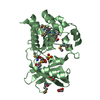

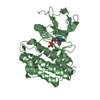
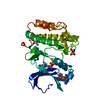

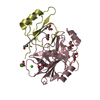

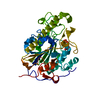

 PDBj
PDBj
